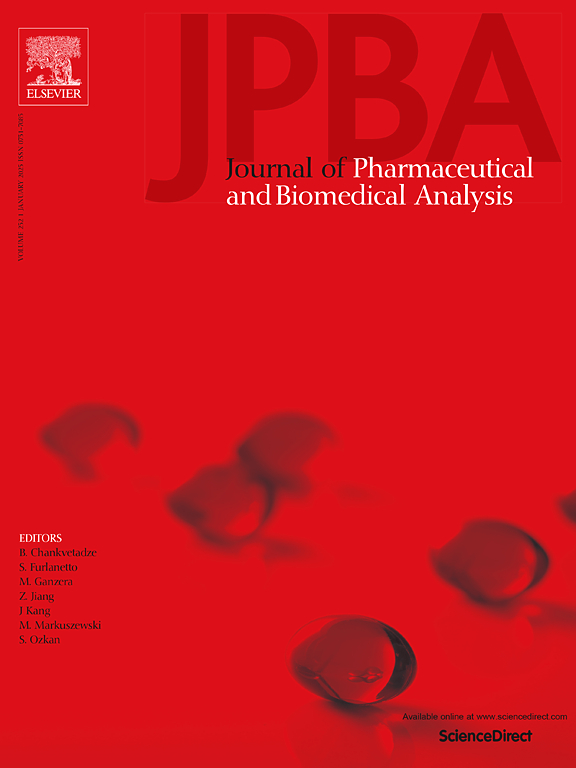Exploring the mechanism of Bruceine D against cervical cancer by network pharmacology and the effect of Bruceine D on the EGFR pathway
IF 3.1
3区 医学
Q2 CHEMISTRY, ANALYTICAL
Journal of pharmaceutical and biomedical analysis
Pub Date : 2025-04-12
DOI:10.1016/j.jpba.2025.116887
引用次数: 0
Abstract
Cervical cancer (CC) remains a formidable challenge in oncology due to its high incidence and mortality rates. Despite recent advances in treatment, an immediate necessity exists for innovating advanced pharmacological interventions boasting augmented effectiveness. Bruceine D (BD), a quassinoid derived from the traditional Chinese medicinal plant Brucea javanica, has been demonstrated to possess notable anticancer properties against a range of malignant conditions, including lung, liver, leukemia, and pancreatic cancers. However, its specific effects on CC have not been thoroughly explored. This study sought to decode the effects of BD on CC through a combined method involving molecular docking analysis, network pharmacology, and data mining. From the PharmMapper database, we identified 58 potential targets of BD, and through GeneCards, we pinpointed 14 intersecting targets relevant to CC. A protein-protein interaction (PPI) network highlighted pivotal targets such as ESR1, HSP90AA1, ANXA5, EGFR, CASP7, and CCNA2. GO and KEGG enrichment analyses underscored significant biological processes and pathways, notably the EGFR signaling pathway. Molecular docking analysis revealed a strong binding affinity of BD to EGFR. Cell-based assays demonstrated that BD potently curtailed the viability, colony formation, adhesion, and mobility of Hela and Caski cells, escalating apoptosis in a dose-proportional manner. Supplementary evidence via western blot evaluations underscored BD’s capability to obstruct the EGFR signaling pathway. These findings suggest that BD exerts potent anticancer effects against CC through multiple mechanisms, positioning it as a promising therapeutic agent for further investigation and clinical validation.
通过网络药理学探讨马钱子碱D抗宫颈癌的作用机制及对EGFR通路的影响
子宫颈癌(CC)由于其高发病率和死亡率仍然是肿瘤学的一个巨大挑战。尽管最近在治疗方面取得了进展,但迫切需要创新具有增强效力的先进药物干预措施。Bruceine D (BD)是一种从中国传统药用植物Brucea javanica中提取的准西葫芦素,已被证明具有显著的抗癌特性,可以对抗一系列恶性疾病,包括肺癌、肝癌、白血病和胰腺癌。然而,其对CC的具体影响尚未得到充分探讨。本研究试图通过分子对接分析、网络药理学和数据挖掘相结合的方法来解码BD对CC的影响。从PharmMapper数据库中,我们确定了58个BD的潜在靶点,通过GeneCards,我们确定了14个与CC相关的交叉靶点。一个蛋白蛋白相互作用(PPI)网络突出了关键靶点,如ESR1、HSP90AA1、ANXA5、EGFR、CASP7和CCNA2。GO和KEGG富集分析强调了重要的生物学过程和途径,特别是EGFR信号通路。分子对接分析显示BD与EGFR具有较强的结合亲和力。基于细胞的实验表明,BD有效地降低了Hela和Caski细胞的活力、集落形成、粘附和流动性,以剂量正比的方式增加了细胞凋亡。通过western blot评估的补充证据强调了BD阻断EGFR信号通路的能力。这些发现表明,BD通过多种机制对CC发挥强大的抗癌作用,将其定位为一种有前景的治疗药物,有待进一步研究和临床验证。
本文章由计算机程序翻译,如有差异,请以英文原文为准。
求助全文
约1分钟内获得全文
求助全文
来源期刊
CiteScore
6.70
自引率
5.90%
发文量
588
审稿时长
37 days
期刊介绍:
This journal is an international medium directed towards the needs of academic, clinical, government and industrial analysis by publishing original research reports and critical reviews on pharmaceutical and biomedical analysis. It covers the interdisciplinary aspects of analysis in the pharmaceutical, biomedical and clinical sciences, including developments in analytical methodology, instrumentation, computation and interpretation. Submissions on novel applications focusing on drug purity and stability studies, pharmacokinetics, therapeutic monitoring, metabolic profiling; drug-related aspects of analytical biochemistry and forensic toxicology; quality assurance in the pharmaceutical industry are also welcome.
Studies from areas of well established and poorly selective methods, such as UV-VIS spectrophotometry (including derivative and multi-wavelength measurements), basic electroanalytical (potentiometric, polarographic and voltammetric) methods, fluorimetry, flow-injection analysis, etc. are accepted for publication in exceptional cases only, if a unique and substantial advantage over presently known systems is demonstrated. The same applies to the assay of simple drug formulations by any kind of methods and the determination of drugs in biological samples based merely on spiked samples. Drug purity/stability studies should contain information on the structure elucidation of the impurities/degradants.

 求助内容:
求助内容: 应助结果提醒方式:
应助结果提醒方式:


